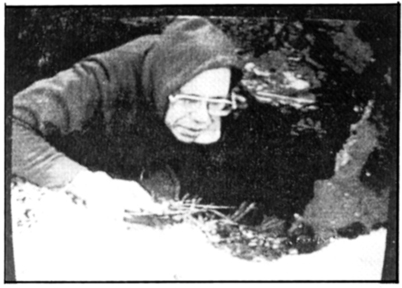
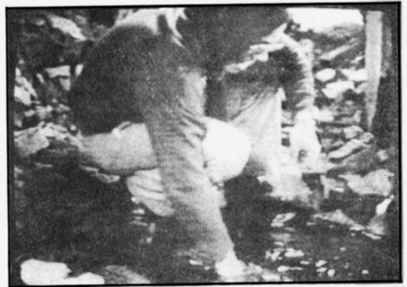
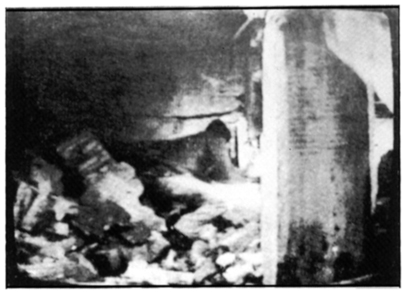
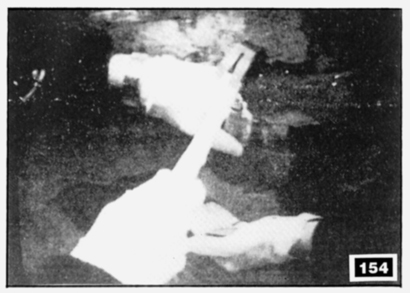
(151 – 154) Fred Leuchter crawling in the accessible part of morgue 1, that is, the ‘gas chamber’, making examinations and taking samples of material from the masonry.

The Zündel trial in Toronto gave rise to intensive research activity among revisionists. It is to Ernst Zündel that we owe the Leuchter report, named after the American gas chamber technologist Fred Leuchter Jr. (for Leuchter’s conclusion see page 12).




(151 – 154) Fred Leuchter crawling in the accessible part of morgue 1, that is, the ‘gas chamber’, making examinations and taking samples of material from the masonry.

(155 – 158) The German chemist Germar Rudolf.
According to the Holocaust scholars, the gassings took place with hydrogen cyanide, which was manufactured in Germany and sold under the trade name of ‘Zyklon B’. The B stands for ‘Blausäure’.
Zyklon B evaporates at 26 degrees C and is diffused into the ambient atmosphere. [Translator’s note: It boils at that temperature, it evaporates right down to the freezing point.]
Hydrocyanic acid reacts with iron forming the compound ferric-ferro cyanide. These are unusually stable and can last centuries.
AN INCREDICLE LUCKY HIT FOR THE REVISIONISTS
For these reason, Leuchter took samples from the mortar from various inside the alleged gas chambers. He took a control sample from a delousing chamber (sample 32). The analysis of this sample by a well known US laboratory shows that sample 32 contained almost one thousand times as much ferric-ferroycyanide as the other samples, which showed no relevant cyanide concentration at all! The inescapable conclusion was that the alleged execution gas chambers had never come into contact with hydro cyanide acid at all (see figure 166).
Fred Leuchter was subjected to a medieval-style witch hunt after the publication of his report, a witch hunt which led to his commercial ruin. His whereabouts are now unknown, in order to escape his tormentors. Fred Leuchter was a gas chamber specialist, but not a chemist or academic. The section of his report which dealt with the chemical aspect of the matter did not fulfill the scientific expectations of the young German chemist Germar Rudolf (see photos 162 to 164 taken during sample taking).
After lengthy theoretical and empirical studies, he published the so-called Rudolf Report, named after him. This expert report rebutted the homicidal gas chamber hypothesis in particularly great detail.
Cyanide compounds are easy to recognize due to their blue color, the acid furthermore owes its name (in German) to this color. Cyanide and iron compounds last centuries, even under rough weather conditions.

(155 and 156) Germar Rudolf took samples from the inside and outside walls a building containing a Zyklon B delousing chamber. The compound formed by the reaction between hydrocyanic acid and iron has penetrated the wall and today, even 50 years later, is clearly recognizable even on the outside wall.
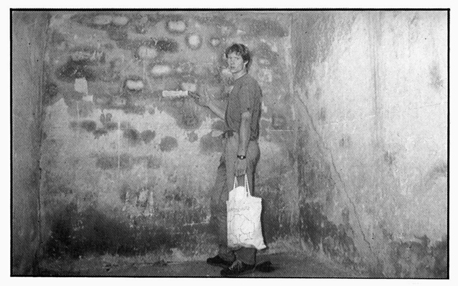
(156) On the inside of the Zyklon B delousing chamber, the walls exhibit penetrating bluish stains.

(158) No blue stains are to be found anywhere on the walls of the ‘gas chamber’, in which mass murders are supposed to have committed and which are protected from the sun and violent storms, laboratory testing shows no relevant content of cyanide residues.
(164) Cyanide concentrations tables. Investigation undertaken by Germar Rudolf, Laborator, Institute Fresenius, Taunsstein, Hessen.
Only the samples taken from the delousing gas chambers (9 to 22) show any significant content of cyanide residues. These are completely absent from the other samples, the latter contain only levels of cyanide residues which normally occur in nature.
This means that these rooms (including the ‘execution gas chamber’) never came into contact with Zyklon B and that therefore mass murders with Zyklon B could never have taken place there.
(165) In the face of scientific research, the Auschwitz liars can only reply with counter-arguments taken from the realm of over-heated fantasy. This is Max Kantor’s depiction of the delousing gas chambers.
(167) Table with cyanide concentrations in the samples brought back by Fred Leuchter. The analysis was performed by Alpha Analytical Laboratories in Ashland, Massachussetts. Sample 32 (from a delousing chamber) shows a concentration of 1050 mg, while all the remaining samples either show no verifiable concentrations or concentrations which are so low as to be only barely verifiable.
(168) The same tests were performed on order of the Auschwitz Museum by the Institute for Forensic Medicine in Cracow, Poland. The local laboratory used a method which was entirely inadequate, but still found no relevant cyanide residues in the ‘execution gas chambers’.
These scientific findings have never been rebutted. Germar Rudolf worked for the famous May Planck Institute in Stuttgart. He lost his job and was sentenced to a term of imprisonment without probation.
Judge A.J. Molhoek in Den Haag (Holland) ordered 2,000 copies of the Rudolf Report confiscated after 500 copies had been sent to Dutch chemistry teachers. In the absence of reliable arguments, the Holocaust must be protected from the revisionists by police truncheons and thought-crimes legislation.
If Auschwitz had been an extermination camp, the Germans would have had to possess some means of corpse disposal. No mass graves have ever been discovered in the vicinity.
The area is no swampy and the water was so high, that recourse to mass graves would have been practically impossible in any case.
It is a fact that five crematoria were erected, with various models of ovens and various oven capacities. This appears extraordinarily suspicious to the first glance. At any rate, all five crematoria were never in use ‘simultaneously’ and were constantly breaking down.
The book by the French pharmacist Jean-Claude Pressac, “Les Crématoires d’Auschwitz” (1933, published in German by Piper under the title Die Krematorien von Auschwitz in 1994), has been praised to the skies by the mass media. But the title is a false promise: there is no trace of a technical treatment of the topic.
The only serious study of the crematoria at Auschwitz and Birkenau so far was written by the Italian Carlo Mattogno
(175) in collaboration with the engineer Franco Deana (176), with the further assistance of a German engineer who has since died. The work appeared in two volumes at Edizioni di Ar. An abridgement appeared in the anthology Grundlagen zur Zeitgeschichte, Grabert Verlag, 1994.
(175 and 176) Carlo Mattogno (left) and Franco Deana (right).
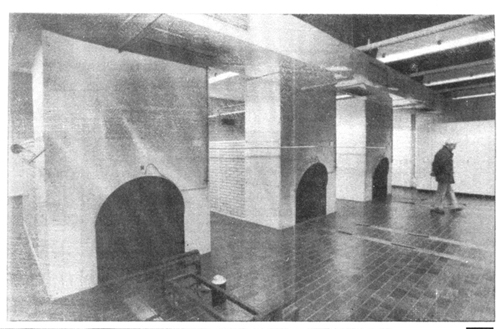
(177) A modern Belgian crematorium, where three to five bodies per muffle are cremated daily.
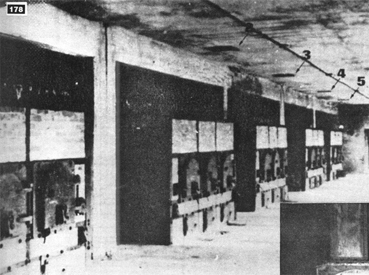
(178) Kremas II and III at Birkenau, which both contained five triple-muffle ovens.
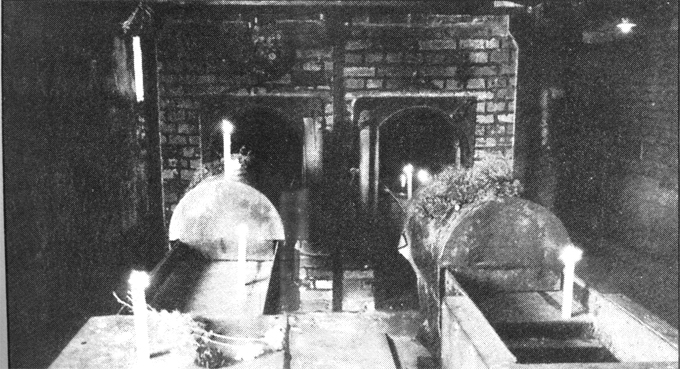
(179) Two-muffle ovens at Buchenwald, similar to Krema I at Auschwitz.
(181) Voucher for 16 ton coke for crematorium Birkenau delivered on 30 April 1943.
(182) Voucher for 4 ton coke carried on 14 March 1943 in railway carriage number.
(183) Voucher for 6 ton coke mixed for division crematorium carried on 16 March 1943 by rail carriage number 11.
(184) The SS administration also needed to estimate the anticipated coke consumption. The illustration is a photocopy of a document dated on 17 March 1943.
The factual basis means that it is very easy to calculate the number of cremations anticipated at that time.
(partial translation of figure 18, dated 17 March 1943)
“Relating to: estimated coke consumption for crematorium II and III according
to the data given by Tops and Sons (oven Builder), dated 11 March 1943.
10 firings = 350 kg/hr
In 12 hours = 12 x 350 = 4,200, for 2 crematoria = 8,400 kg
With constant use, these values are considerably lessened, so that one may calculate 2/3 of this quantity. For crematoria II and III therefore consumption in 12 hours = (350 x 12) > 3 x 2 = 5.600 kg.
Crematoria Iv + V:
(35 x 4x 32 x) > 3 x 2 = 1120 x 2 = 2,240 kg in 12 hours.
Totals: Krema II = 2,800 kg
Krema III = 2,800 kg
Krema IV = 1,120 kg
Krema V = 1,120 kg
Total = 7.840 kg in 12 hours (daily)
These are peak performance figures! They do not indicate annual consumption, since the number of hours requiring heating cannot be known in advance (end of partial translation).
Mattogno: “The 5.600 kg coke anticipated for crematoria II and III correspond to the cremation of (5.600 [divided by] : 20.3) = 276 emaciated corpses. The 2,240 kg coke anticipated for crematoria IV and V would suffice for the cremation of (2,240 : 15.5) = 146 corpses. This corresponds to a total of 422 corpses. Since we must assume a twelve-hour period of operation per crematorium per day, with the other 12 hours per day being spent in cooling and repairing the ovens, the indicated quantity of coke also includes the quantity required to re-heat the ovens….”
According to the above, the hypothetical number of corpses to be cremated amounted to maximum 320 bodies.
The conclusion of the two authors is as follows: “… This proves that the SS plainly anticipated the cremation of corpses of registered inmates and did not plan the cremation of any gassing victims …”
(185) The Germans maintained an efficient administration and kept exact books on the strength of the camps at all times.
A considerable proportion of the documentation has survived intact, including 45 death books, containing the most important information on all mortality cases.
(185bis) A crematorium is an installation with specific technical characteristics and capacities, which are very exactly known, both in theory and practice we quote the following from Deana and Mattogno’s research:
“The maximum cremation capacity of the crematoria of Auschwitz and Birkenau amounted to 1,040 and 1,248 daily. From the documents, we know the number of days on which the crematoria were in operation. If the crematoria had functioned on an interrupted basis during their period of operation, they would have been hypothetically able to burn the following numbers of corpses:
Crematoria II and III: (915 – 212 days) x 192 corpses per day = 134,976 corpses.
Crematoria IV and V: (279 – 70 days) x 192 corpses per day = 40,128 corpses.
In total, it would have been impossible to cremated more than 293,208 corpses. This is about half the total number of gassing victims indicated by Pressac. In this case, it would have been impossible to cremated the corpses of inmates who died of natural causes.”
Mattogno and Deana: “Since we know both the practical and theoretical coke consumption for the cremation of a corpse, the following empirically tested conclusions are inescapable”:
The Topf double-muffle oven of the model used at Auschwitz required the following quantities of coke for the cremation of one corpse under continual operation:
Normal corpse: 25 kg coke
Slim corpse: 28 kg
Badly emaciated corpse (“Moslem” in camp slang): 30.5 kg
The coke consumption of the triple-muffle oven amounts to 16.7 kg, 18.7 kg and 20.3 kg.
“… From the above data, the following conclusion can be drawn, the coke deliveries from March to October 1943 provide irrefutable proof that only corpses of inmates having died natural deaths were burnt in the crematoria. Therefore, no mass murders by gas were committed during the period of March to October 1943…”
“ According to the ‘Calendarium’ of Danuta Czech, the standard work in support of the official theory, at least 522,000 people were gassed and burnt during the period between 1 January 1944 and 30 October 1944. The calculations show, however, that theoretically, the crematoria could only have disposed of 126,960 corpses and that in this case, therefore, the remaining (approximately) 395,000 corpses must have been burnt in the cremation ditches (which were described by eyewitnesses, but not a trace of which has ever been found.”
REFRACTORY BRICK MASONRY
The refractory birch masonry of a crematoria oven usually disintegrates after the cremation of about 3,000 corpses, under very favorable circumstances. In view of the facts of the case, the authors come to the following conclusion:
“On the basis of the above, it may be concluded that the ovens of Auschwitz I and Birkenau could have burnt approximately (138,000 + 24,000) = 162,000 corpses. This number corresponds quite exactly to the number of inmates who can be proven to have died of disease. The cremation of the alleged gassing victims was therefore an impossibility.”
CREMATIONS IN OPEN-AIR DITCHES
Eyewitnesses claim that when the crematoria were ‘overloaded’, the corpses were burnt in the open in ditches. The wildest stories are current on this point. One of the most important eyewitnesses to the cremations is Filip Mueller, he describes the procedure on several pages in great detail. According to him, the layers of bodies were piled up on tope of each other in a ditch, upon which wood was piled upon the top layer and set in fire.
The cremations in open-air ditches described by Mueller and the other eyewitnesses are technically quite impossible. The two authors come to the following conclusion:
“ To burn the bodies in the manner described by him (Mueller), they would have had to sack them in alternate layers with wood in between. Since such a stack would receive no draught of air for combustion from the bottom and very little draught from on top, due to the convection of heat and obstruction caused by the thick stacking of bodies, such an arrangement could only have smoldered.”
(186 – 189) Alfred Kantor’s recollection of daily life at Auschwitz:
“ The crematoria burn 20,000 per day.”
“ 1,000 gassing victims [Vergasungsopfer] in 14 minutes.“
“ Good conduct had the result of ‘being sent to the crematorium.”
“ Living infants were burnt with petrol under the open sky.”
Comment is superfluous.
(186) Many inmate drawings show crematoria with black smoke billowing out of the chimneys. In reality, crematoria chimneys issue very little smoke and no smell at all.
(187) A few witnesses speak of a stairway leading to an underground room, according to other witnesses, the victims entered the crematorium through an ordinary door. The eyewitnesses testimonies all contradict each other.
(188) although the inmates got out of the trains at a railway platform which was only 200 m away from the crematorium, according to this drawing they were conveyed to the crematorium by lorry.
According to Alfred Kantor, the inmates were gassed for good behavior and shot for good behavior!
(189) Alfred Kantor, an Auschwitz survivor and artist, loses all control over himself when painting crematoria and cremation ditches.
(190 – 200) Deportation under barbaric circumstances, beating with truncheons and whips, vicious dogs and arbitrary executions.
The photos, by contrast, show ordinary procedures of reception into the camp. German soldiers walk calmly about among the new arrivals. The arrivals show no signs of panic or fear.
In contrast to the eyewitness testimony of the Belgian woman Regine Beer: “SS men to us whip in hand.” Page 46: “Those who had suffocated during the journey were dragged out of the car and immediately burnt.”
On the other hand, one sector of Birkenau was designated as a ‘family camp’. BII was planned for the reception and processing of patients from the various work camp in the area. All this contradicts the extermination theory.
(190 – 200) Regine Beer continues in the French edition.
“SS soldiers came to us, whip in hand. Men, woman and children were immediately separated. At the end of the road stood the camp commandant or doctor. With a movement of the hand to the right or the left, they decided whether the people were to die immediately or whether they had the right to live a bit longer.
“ The old, the sick, the weak, people with a child in their arms or by the hand, pregnant women and entire groups were immediately sent to the left. To be gassed and burned, but we didn’t know that yet.”
All this corresponds to the official dogma. We have all read similar descriptions of the selection upon arrival at Auschwitz. It has since been shown that the ‘selections for gassing and burnings’ are sheer fantasy. As noted by Boisdefeu on the basis of several official documents, the right-hand of the convoy which included Regine Beer (the line of people who were fit to work), included, as correctly stated in the official history, 99 women who were registered under the numbers A5143 to A5211 (Regine Beer received A5148), while the left-hand line (the line with the women, children, sick people, etc., who were believed to have been gassed), included a child 9 years of age named R. Friedel and his mother, T. Esther – both of whom returned to Belgium after the liberation of the camp! They were not gassed at all (we fail to see why the other persons considered ‘unfit to work’ in the same line should have gassed either). Rather, they were simply sent to the family camp – nothing more! At this time, those considered ‘unfit to work’ could not be sent to camps further East, in the USSR, because of the advance of the Red Army and were therefore apparently housed at Auschwitz itself. Our two heroines then underwent a second selection, after which they still were not gassed (for the simple reason that nobody was ever gassed at Auschwitz, (but were registered at the same time as the Czechoslovakian and Hungarian Jews – number A5769 for the mother and A3099 for the daughter.
(201) “During their stay in the concentration camp, those who fit to work were lodged in armaments factories for the utilization of their labor. The children were separated from their parents and sent into the gas chambers immediately after their arrival with the old and the sick, the Jews who were no longer able to work.”
(202 and 203) The infamous selection. Children, old people and sick were allegedly murdered and burnt immediately. In reality, they were lodged in the family camp or sent to another camp. For example, Ellie Wiesel or Simone Veil (253 left) were still children during their deportation, so was Anne Frank. She wasn’t gassed but transferred to Bergen-Belsen. In Buchenwald, more than 1,000 children were released, who had been transferred there from Auschwitz, children can be seen even in photos taken after the liberation of Auschwitz (224 – 226).
See before (190 – 200): Regine Beer
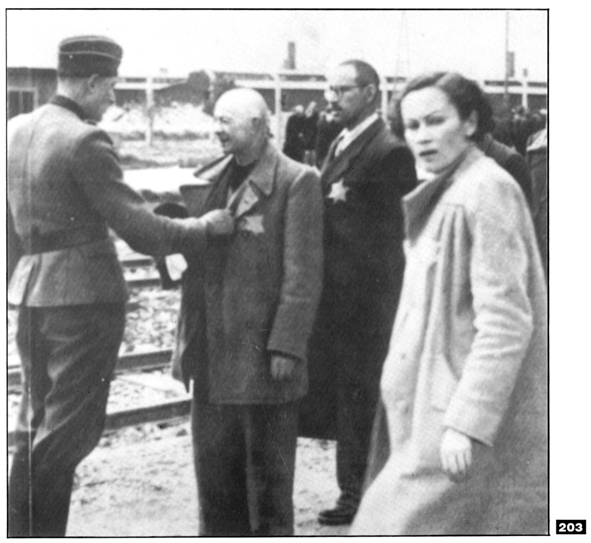
(203) this famous photo, which also appears on the cover of J.-C. Pressac’s Les Crématoires d’Auschwitz, appears constantly in the media. A women with a star of David strides past the line of men. She does not seem to suffer from any particular fear of the German soldiers.
In a Japanese camp, she would have had to bow respectfully.

(204) The prototype Hollywood German.
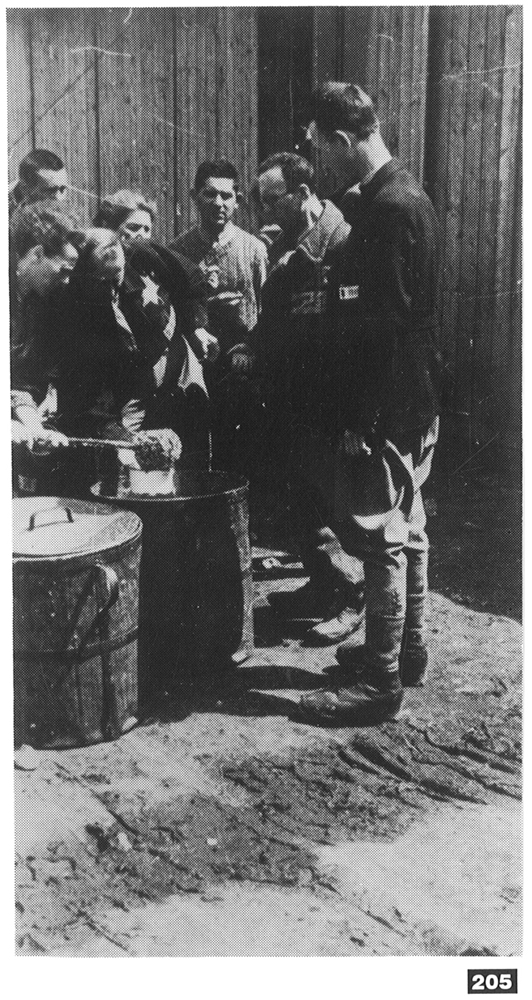
(205) Distribution of food in the Plaszow camp, which also appears in Stephen Spielberg’s list. It should be noted that they prisoners are well-fed and clothed and are wearing decent shoes.

(206) Food being brought to the barracks on a horse-drawn wagon. These photos also originate from the Plaszow camp. Drainage ditches are visible everywhere.
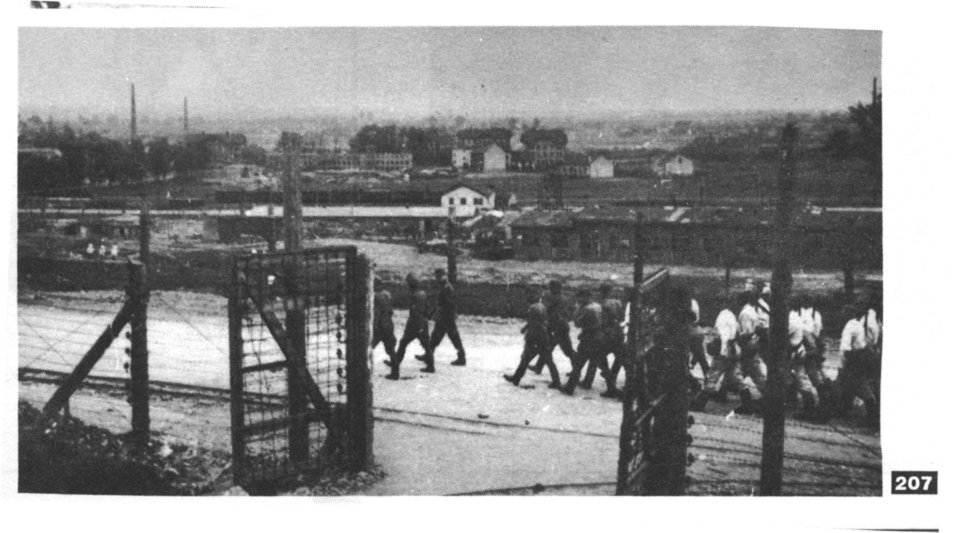
(207) Authentic photograph of Plaszow camp. It should be noted that the soldiers accompanying the prisoners are unarmed.
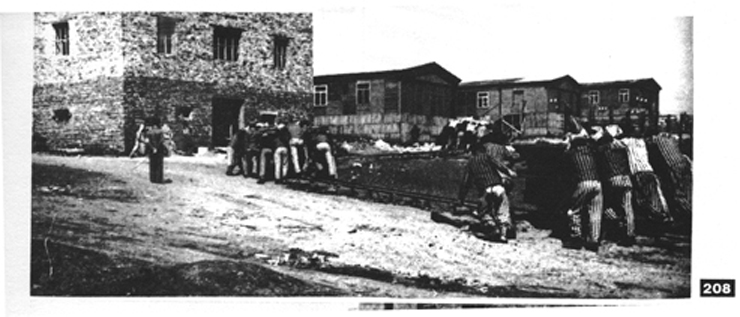
(208) Scene from Plaszow: inmates pushing a cart loaded with stones out of the pit. To the left: an onlooker.
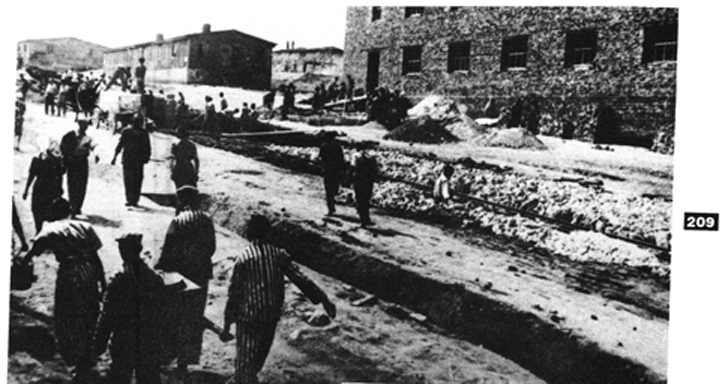
(209) Plaszow: roads in the camp being asphalted. To the left: four prisoners carrying a canister with food.
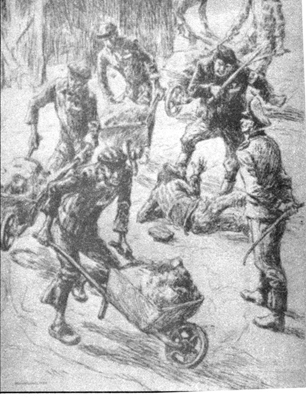
(210 and 211) If the prisoners were terrorized, the guilty parties were mostly Kapos and foremen, in other words other prisoners. In this regard, Regine Beer complains about the Polish Kapos more than the Germans. Of these Kapos, she writes (page 57). “At the top of a working crew was a Kapo. These were mostly Poles. The Polish women never left us alone for a moment. Maintenance of peace and quiet were their favorite task, and the end justified the means. They withheld a portion of the rations from their fellow prisoners (page 59). They weren’t afraid of anything since in most cases they had already been to prison as criminals. They beat us right away and with great pleasure, that was plan to see.
Frans Fisher in L’Enfer de Breendonck: “Once one of the chiefs (Kapos) thought we weren’t marching fast enough, so he hit me on the kidneys with a truncheon. This chief bore the yellow stripes on his jacket which designated an Israelite.”
In fact, the internal organization and administration of each German concentration camp was entrusted to the inmates themselves, since there was a lack of guard personnel as all the available men were at the front. The SS restricted itself to supervision and guard duties. Most of the inmates therefore had very little contact with SS personnel. Many inmates admit that they were better treated by SS men than by their fellow prisoners.
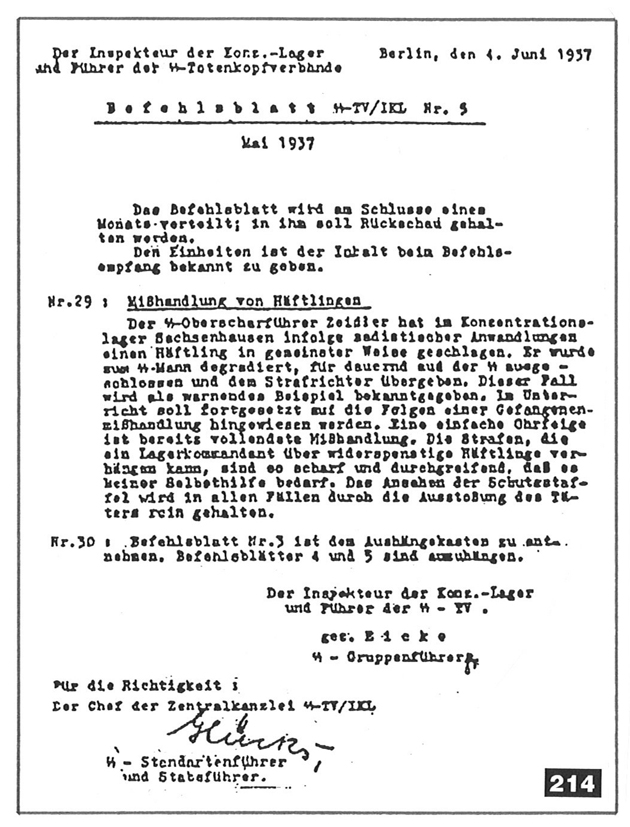
(214) The orders for the German SS guard personnel was unequivocal, mistreatment was strictly forbidden!
TRANSLATION OF DOCUMENT SHOWN ABOVE
The inspector of the concentration camp Berlin, 4 June 1937 and leaders of the SS Death’s Head Association.
Order Sheet SS TV/IKL n° 5
May 1937
The order sheet is distributed at the end of a month, it is intended to contain a retrospective summary. The contents are to be made known to the units upon receipt of the order. N° 29: Mistreatment of prisoners SS Oberscharführer Zeidler, in the concentration camp Sachsenhausen, as the result of sadistic impulses, struck an inmate in the most beastly way. He was demoted to SS man, permanently discharged from the SS and handed over to a criminal judge. This case is cited as a deterrent example. Constant reference must be made during training to the constitute mistreatment. The punishments which a camp commandant is empowered to inflict upon a recalcitrant prisoners are so severe and thorough, that there is no need for any self-help. The decency of the SS will be kept pure in all cases by the expulsion of the criminals.
END OF PARTIAL TRANSLATION
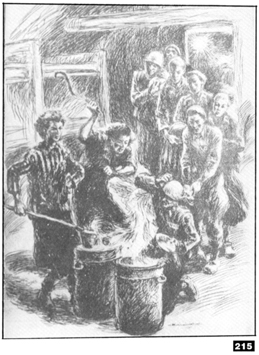
(215) Distribution of food. This drawing appears in M. Koscielniak (Ondergang. De vervolging en verdelding van het Nederlandse Jodendom, Dr. J. Presser).
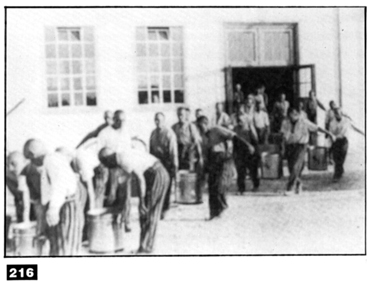
(216) Distribution of food in Dachau 1938. The good condition of the Dachau inmates before the war indicates that the camp was designed as an installation for the imprisonment, principally, of serious criminals, as well as Communists, with a poor outlook for rehabilitation or ‘re-education’. When the camp was forced to accept more and more prisoners due to the circumstances of the war, these serious criminals and communists, who had already been interned for considerable periods of time, were entrusted with key positions. They only thought of their own interest and their own survival and as a result, simply followed their own instincts and felt no solidarity with the fate if the thousands of political prisoners on their conscience. The political inmates and Jews were involved in a bitter struggle for survival against the common criminals. See, in this regard, the books of the revisionist Paul Rassinier, who personally experienced the camps of Buchenwald and Dora.
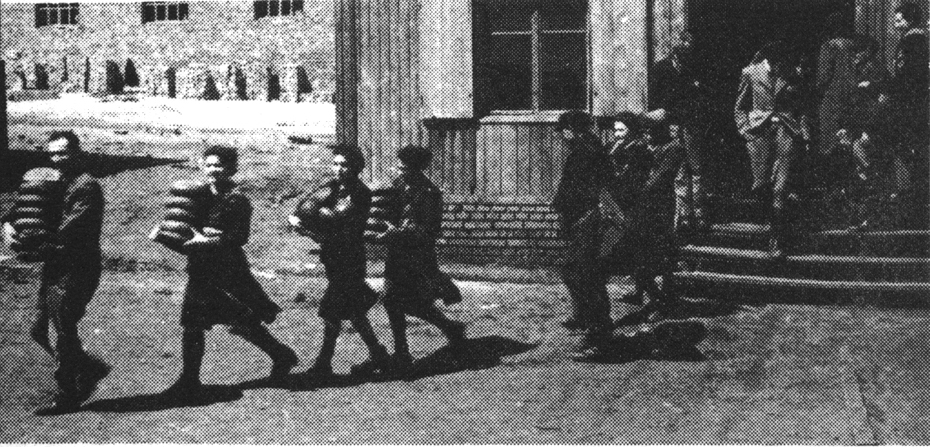
(217) Plaszow. Cheerful-looking inmates bringing bread from the kitchen to the barracks, with civilians standing around in the background.
(215) These drawings are hardly compatible with the order reproduced in (214).

(218) Report from the Prague Post Office of 20 September 1943. It involves a payment made on 8 June 1943 in favor of the prisoner Otakar Litomisky booked in his favor at Auschwitz on 18 July 1943.
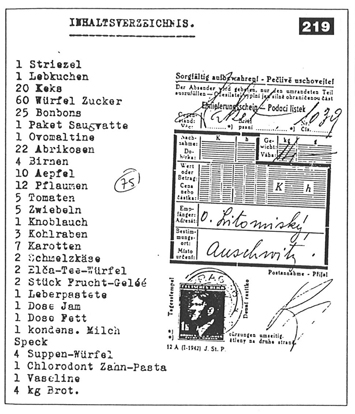
(219 and 220) Voucher for the mailing of a package of food on 26 July 1943 to the prisoner Otakar Litomisky in Auschwitz concentration camp. The sender was instructed to draw up a statement of the contents of the package duplicate, one copy was sent with the package, the other was to be kept. Inmate no. 113359 Otakar Litomisky only received one of the packages sent to him at Auschwitz and that one was plundered almost empty (source: Brieven uit de hel. Herinneringen van gevangene Otakar Litomisky, n° 113559, Voselaar, 1992).
It was Litomisky’s fellow inmates who were responsible for the plundering of the packages.

(221) This is the American horror story version of life in the camps, in which the evil Nazis were responsible for everything.

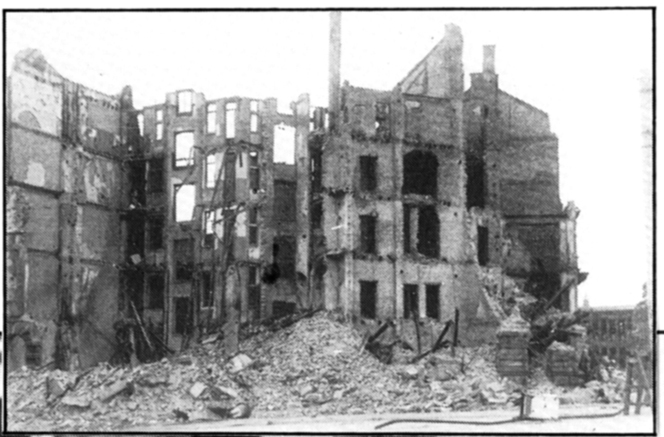
(222 and 223) While German cities were bombed flat, here is a report on Dresden, where Allied terror bombers killed more than 250,000 people between the 13th and 15th of February of 1945 while the evil Germans did their best to save thousands of inmates.
FULL TRANSLATION OF THE DOCUMENT
The Higher Police and SS Leaders. Dresden, 22 March 1945.
The Commander of the Ordnungspolizei ‘Security Police’.
Routine order n°47.
To counter wild rumors, the following short extract from the Police President of Dresden on the 4 attacks dive bombs.
13,441 houses were totally destroyed or severely damaged, i.e. 36% of all the houses in Dresden.
The following were also totally destroyed or so severely damaged that they could no longer be used.
30 banks 647 shops
36 insurance buildings 2 museums
31 warehouses and department stores 19 churches
32 large hotels 6 chapels
25 large guest houses 22 hospitals and clinics
75 administration buildings 72 schools
6 theatres 5 consulates, including the
Spanish and Swiss consulates
In the refrigeration storage house, only 180 barrels (50 kg each) were destroyed, all other stocks were saved.
By the evening of 20 March 1945, 202,040 bodies had been recovered, the majority women and children.
The death total must be expected to rise to 250,000; only approximately 30% of the dead could be identified.
The Ordnungspolizei (security police) of Dresden suffered 75 killed and 276 missing, who, for the most part, must be presumed dead. Since the dead could be not carried away and buried, either rapidly or in time, 68,650 of the dead were cremated and the ashes scattered in the cemetery.
Since the rumors far exceed the reality, official use may be made of the actual figures.
The losses and damage are severe enough.
The entire severity of the attack lies in the fact that this degree of damage was caused in a few hours.
For the Commander of the Ordnungspolizei (Security Police) The Chief of Staff, signed Grosse. Colonel of the Schutzpolizei (Security Police).
END OF TRANSLATION OF DOCUMENT
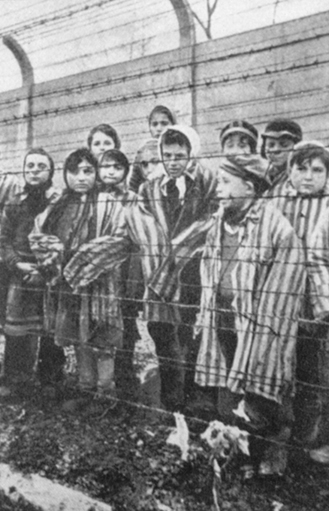
(224) Healthy-looking children during the liberation of Auschwitz.
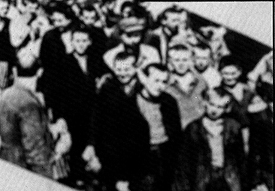
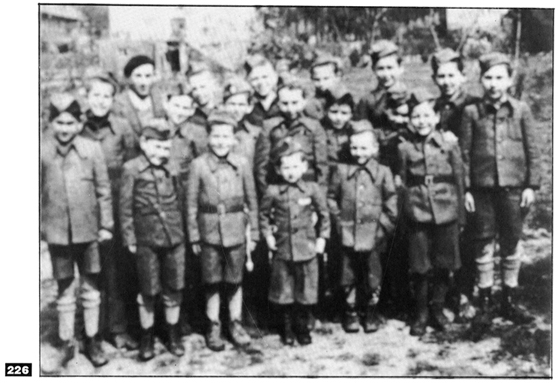
(225 and 226) Block 11 in Buchenwald was the children’s block. Upon the liberation of the camp, the block contained more than 1000 children who had been transferred here from Auschwitz at the end of the war and who looked very healthy.
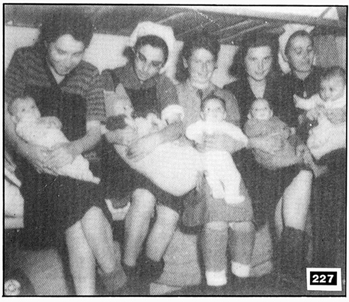
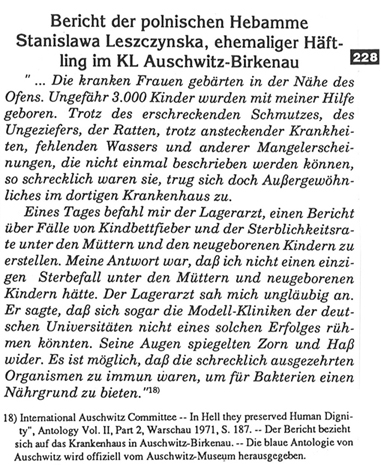
(228) What is one to think of the statement of the Polish midwife Stanislawa Leszczynska and the healthy infants in photo n° 227?
TRANSLATION OF REPORT N° 228
Report of the Polish midwife Stanislawa Leszczynska, former inmate of Auschwitz-Birkenau.
“… The sick women gave birth in the vicinity of the oven. Approximately 3,000 children were born with my help. Despite the fearful dirt, the vermin, the rats, despite contagious diseases, the lack of water and other deficiencies, which cannot even be described, they were so terrible, extraordinary things happened in the hospital there.”
One day, the camp doctor ordered me to draw up a report on cases of puerperal fever and mortality among the mothers and new-born children. My answer was that I had never had a single case of mortality among the mothers and new -born children. The camp doctor looked at me with astonishment. He said that not even the model clinics at German universities could boast of such success. His eyes reflected scorn and hatred. It is possible that the emaciated organisms were too immune to offer a breeding ground for bacteria
(Source: International Auschwitz Committee – In Hell They Preserved Human Dignity – Anthology volume II part 2, Warsaw 1971, page 187. The report relates to the hospital in Auschwitz-Birkenau. The blue Auschwitz anthology is an official publication of the Auschwitz Museum.
Chapter Five